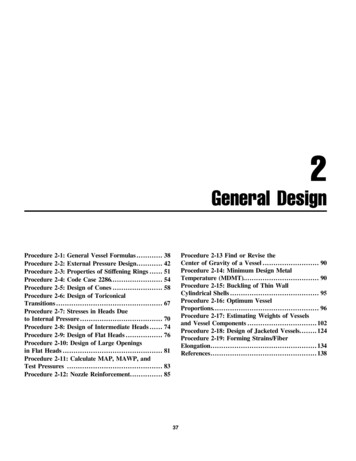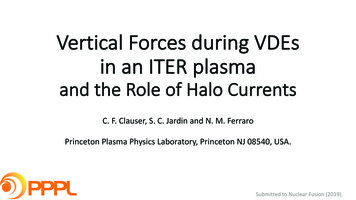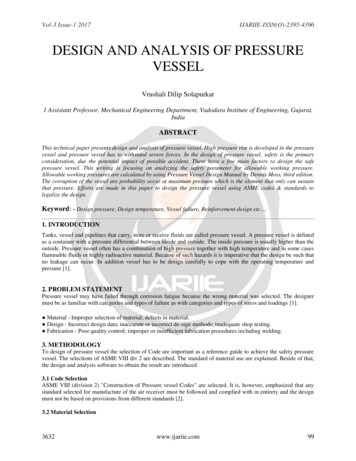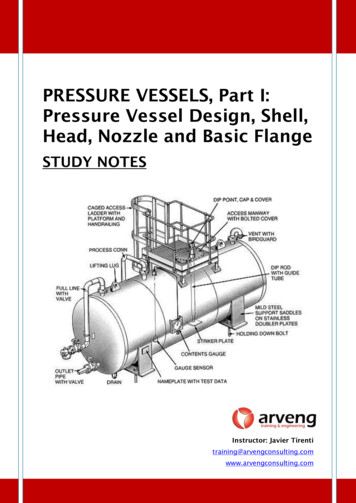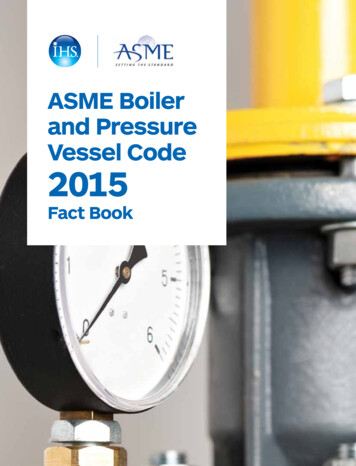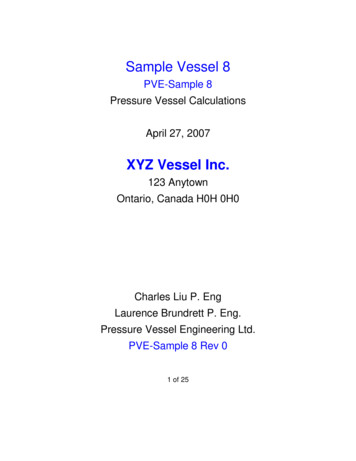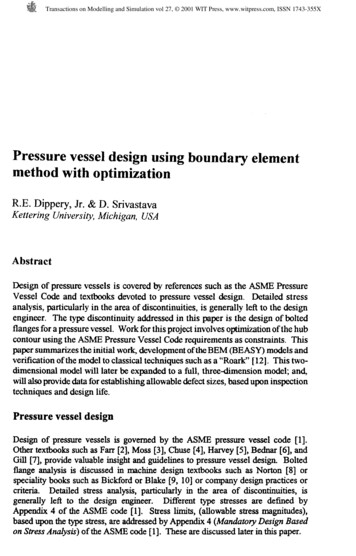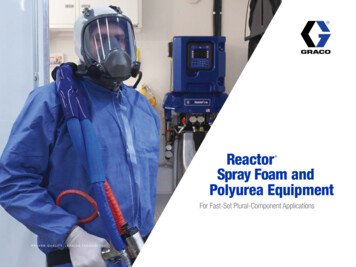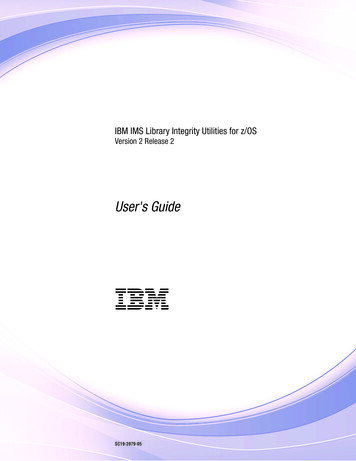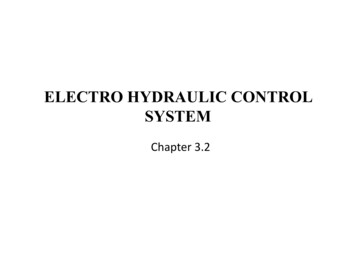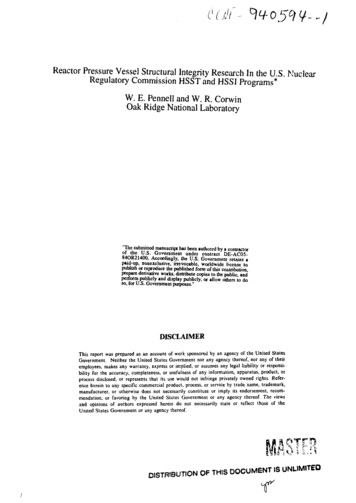
Transcription
Reactor Pressure Vessel Structural Integrity Research In the U.S NuclearRegulatory Commission HSSTand HSSI Programs*W. E. Pennell and W. R. CorwinOak Ridge National Laboratorylire submitted manuscript has been authored by a contractor2i«!t h S 70?' G o v e r n m ! ' 1 under contract DE-AC0584OR21400. Accordingly, the U.S. Government retains ap»id-up, nonexclusive, irrevocable, worldwide license lopublish or reproduce the published form of this contributionprepare derivative works, distribute copies to the public, andperform publicly and display publicly, or allow others to doso, for U.S. Government purposes."DISCLAIMERThis report was prepared as an account of work sponsored by an agency of the United StatesGovernment. Neither the United States Government nor any agency thereof, nor any of theiremployees, makes any warranty, express or implied, or assumes any legal liability or responsibility for the accuracy, completeness, or usefulness of any information, apparatus, product, orprocess disclosed, or represents that its use would not infringe privately owned rights. Reference herein to any specific commercial product, process, or service by trade name, trademark,manufacturer, or otherwise does not necessarily constitute or imply its endorsement, recommendation, or favoring by the United States Government or any agency thereof. The viewsand opinions of authors expressed herein do not necessarily state or reflect those of theUnited States Government or any agency thereof.DISTR.BUTION OF TH.S DOCUMENT IS UNLIMITED
Reactor Pressure Vessel Structural Integrity Research In the U.S. NuclearRegulatory Commission HSST and HSSI ProgramsW. E. Pennell and W. R. CorwinOak Ridge National LaboratoryDevelopment continues on the technology used to assess the safety of irradiation-embrittled nuclearreactor pressure vessels containing flaws. Fracture mechanics tests on reactor pressure vessel steel haveshown that (a) local brittle zones do not significantly degrade the material fracture toughness,(b) constraint relaxation at the crack tip of shallow surface flaws results in increased fracture toughness,and (c) biaxial loading reduces but does not eliminate the shallow-flaw fracture toughness elevation.Experimental irradiation investigations have shown that (a) the irradiation-induced shift in CharpyV-notch versus temperature behavior may not be adequate to conservatively assess fracture toughnessshifts due to embrittlement and (b) the wide global variations of initial chemistry and fracture propertiesof a nominally uniform material within a pressure vessel may confound accurate integrity assessmentsthat require baseline properties.INTRODUCTION1. Regulatory requirements limit the permissible accumulation of irradiation damage in thematerial of a reactor pressure vessel. Irradiationdamage limits are set such that required fractureprevention margins are maintained throughout thenuclear plant licensed operating period.Regulatory requirements are based on fracturemechanics technology and utilize materials agingdata drawn from mandatory reactor vessel irradiation damage surveillance programs.2. In recent years it has become evident that anumber of nuclear plants will exceed the regulatory limits on irradiation damage to the reactorvessel material before the end of their currentoperating license period (ref. 1). One result fromthis development is that a number of nuclearindustry organizations have gained experience inthe application of fracture margin assessmenttechnology. This experience has resulted in theidentification of a number of issues with thetechnology in its present form. Data fromirradiation testing programs, operating plantsurveillance programs, and large-scale fracturetechnology validation tests have identifiedadditional issues. The Nuclear RegulatoryCommission (NRC)-funded Heavy Section Steel"Research sponsored by Office of Nuclear RegulatoryResearch, U.S. Nuclear Regulatory Commission underImeragency Agreement 1886-8011-9B with the U.S.Department of Energy under contract DE-AC0584OR21400 with Martin Marietta Energy Systems, Inc.Technology (HSST) and Heavy Section SteelIrradiation (HSSI) Programs at Oak Ridge NationalLaboratory (ORNL) are performing the researchrequired to resolve these issues and further developand refine the fracture margin assessmenttechnology.3. This paper presents a brief overview of thecurrent status of fracture prevention regulatoryrequirements and the associated fracture marginassessment technology. Issues identified with thetechnology are reviewed, and some of the researchprograms implemented to resolve those issues aredescribed.REGULATORY REQUIREMENTS ANDRESEARCH NEEDS4. Irradiation embrittlement and low vesseltemperatures both act to reduce the cleavagefracture toughness of reactor vessel material.Regulatory requirements for fracture prevention,therefore, focus on operating and potential accidentconditions that generate both low temperatures andhigh stresses in the reactor vessel material. Forsome vessels, however, an additional concernexists at higher operating temperatures. Thesevessels contain materials with a reduced resistanceto failure by ductile tearing. Additionalrequirements are placed on vessels in this lattercategory to assure that adequate ductile tearingfracture prevention margins are maintained.5. A summary of the regulatory process forassuring retention of adequate fracture preventionmargins in reactor pressure vessels is presented in
Fig. 1. A mandatory reactor vessel surveillanceprogram (refs 2,3) provides data on the progressiveeffect of irradiation embrittlement on the vesselmaterial fracture toughness. Changes in fracturetoughness are measured using small Charpyspecimens rather than large fracture toughness testspecimens and are expressed in terms of (a) lateraltranslation (ARTNDT) of the Charpy energy curveat the 41-J (30 ft-lb) energy level and (b) decreasein the upper shelf fracture energy (AUSE) of thematerial. Regulatory requirements for preservationof required fracture prevention margins areexpressed in terms of an adjusted reference nilductility transition temperature (RTNDT) (refs 4-6)and a minimum acceptable level of upper shelfenergy (USE) (ref, 4)6. Surveillance piogram data are used toperiodically adjust the upper bound to the reactorpressure-temperature (P-T) operating envelope(refs 5, 7), as shown in the left-hand branch inFig. 1. Adjustment is required to maintain marginsagainst fracture of 2 on pressure loading and 1 onsimultaneously applied thermal loading. Fractureprevention margins are calculated assuming aninner surface flaw, having a depth corresponding to25% of the wall thickness. The fracture marginassessment analysis must be performed usinglower-bound (KIR) dynamic fracture toughnessproperties (ref. 5). Adjustment of the P-T curve inresponse to irradiation embrittlement of the reactorvessel material has the effect of restricting thepermissible reactor P-T operating envelope, asillustrated in Fig. 2. It is evident from Fig. 2 that ahigh irradiation-induced RTNDT can restrict theP-T operating envelope to the point where reactorheatup and cooldown become very difficultUH IRRADIATEDIRRADIATION DATAFROM MATERIALSTEST REACTORSPOWER P U N TSURVEILLANCEDATATEMPERATUREjP-TLWTS1 P.T.S. LIMITS USE LIMITSI 10CFR50.APP.GBHrTUE FRACTUREDETERMINISTIC ANAL.114 1 FLAWS S. 2 0. . . fOCFHSMIREG. GUIDE 1.154MUED-MODE FRACTUREPROBABILISTIC ANAL.FLAW POPULATION«F)SS»1C"I 1DCFRSO.APP.OUSESSOft.fe.DUCTILE TEARINGCODE CASE N413DRAFT REGULATORYGUIDE OC-102)Fig. 1. Regulatory requirements limit permissibleirradiation embrittlement of reactor vesselmaterials such that adequate fracture preventionmargins are maintained under both operating andpotential accident loading conditions.OPERATING PRESSUREMINIMUM PRESSURE FCOOLANT TEMPERATURE— -Fig. 2. Adjustment of reactor P-T curve inresponse to irradiation embrittlement of vesselmaterial severely restricts permitted reactoroperating envelope.operations. This is particularly true for reactorswith a fixed setpoint low-temperature overpressureprotection (LTOP) system. This difficulty hassparked interest in refinement of the technologyused to define the P-T curve and the associatedLTOP setpoint. Specific research topics relating tothis issue include (a) the effect of local brittlezones and pop-ins on the material fracturetoughness and (b) improved correlations forpredicting the irradiation-induced shift in thematerial RTNDT-7. The center branch of Fig. 1 summarizes theregulatory requirements for demonstration ofacceptably low failure probability when the reactorvessel is exposed to pressurized thermal shock(PTS) loading. A probabilistic PTS analysis isrequired when irradiation damage has caused theadjusted RTNDT for the vessel material to reachscreening Limits. These limits have been set at132.2 C (270 F) for plates, forgings, and axialweld material and 148.9 C (300 F) for circumferential weld material (ref. 6). Acceptablemethodology for performing a plant-specificprobabilistic PTS analysis is defined in NRCRegulatory Guide 1.154 (ref. 8).8. Principal features of the fracture mechanicselements of the PTS analysis procedure areillustrated in Fig. 3. Thermal stresses are highestadjacent to the inner surface of the vessel wherethe effects of irradiation embrittlement andtransient temperatures combine to produce themaximum reduction in the material fracturetoughness. The net result from this combination ofconditions is that the majority of crack initiationsare predicted to originate from shallow flawslocated in the inner surface of the vessel. Thedominant influence of shallow surface flaws
INITIATION(- (SHALLOWFLAW)00.2\C.40.60.8»/W, FRACTIONAL WALL AND FLAW DEPTHFig. 3. Intersection of applied K\ curve (stress andflaw geometry dependent) with material fracturetoughness curves (temperature, fluence, andmaterial dependent) defines crack initiation andarrest behavior at point in time during a PTStransient.generates a need for quantitative assessments of(a) the effect of reduced crack-tip constraint on thematerial fracture toughness associated withshallow flaws, (b) the effect of prototypical biaxialstress states on the material shallow-flaw fracturetoughness, and (c) the effect of stainless steelcladding on the initiation of cracks from shallowsurface flaws.9. The requirement for the reactor vesselmaterial to maintain a minimum USE not less thanthe 68-J (50-ft-lb) regulatory limit is reflected inthe right-hand branch of Fig. 1. The regulatoryrequirement (ref. 4) states that this condition mustbe maintained "unless it is demonstrated in amanner approved by the Director, Office ofNuclear Power Regulation, that lower values ofupper shelf energy will provide margins of safetyagainst fracture equivalent to those required byAppendix G of the ASME Code." Acceptableprocedures for demonstrating the retention ofadequate margins against fracture for low-uppershelf (LUS) material have recently been publishedin American Society of Mechanical Engineers(ASME) Code Case N-512 (ref. 9) and DraftRegulatory Guide DG-1023 (ref. 10). Theseprocedures evaluate the stability of a referenceflaw in LUS material using an irradiation-adjustedmaterial J-R curve. A need exists therefore for aJ-R curve data base for LUS materials.FRACTURE MECHANICS RESEARCH10. Local brittle zones and pop-ins. McCabeet al. have evaluated the Kit scatter band andlower-bound toughness for pressure vessel materialboth with and without pop-ins (ref. 11). Resultsfrom their evaluation are reproduced in Fig. 4.They show that in general the pop-in results laywithin the K]c scatter band for specimens thatfailed without pop-ins. At most, the inclusion ofthe pop-in data marginally lowers the lower boundof the K]c data. The interim conclusion from thisresearch on irradiated material is that it appearsthat a case can be made for the use of a fracturetoughness curve higher than the KIR curve fordefining reactor LTOP setpoints. The selectedcurve, however, may not be as high as the Recurve. Additional data for irradiated material mustbe included in the data base before this interimconclusion can be validated.11. Crack-tip constraint effects for shallowflaws. Fracture occurs when the opening-modetensile stresses at the tip of a crack in a brittlematerial exceed a critical value over a finite length(ref. 12). Local yielding of the material at thecrack tip limits the buildup of opening-modestresses and thereby directly influences fracturetoughness. Tensile hydrostatic stresses contributedirectly to the crack-tip opening-mode tensilestresses but do not influence yielding. Crack-tipconstraint is the term used to describe conditionsthat influence the hydrostatic component of thecrack-tip stress field. Low constraint reduces thehydrostatic stress contribution to the opening-modestress and thereby increases fracture toughness.Shallow flaws in a reactor pressure vessel havereduced crack-tip constraint because of theproximity of the inner surface of the vessel.Shallow-flaw fracture toughness would thereforeAn0" Kj. *»IT POP-INA J T -POP-IN T POP-IN I? 2 LOWEH BOUNDPOP-IN L O W E R B O U N DSOU9510STEST TEMPERATURE ( C )Fig. 4. Test data for irradiated high-copper weld(73W) indicate that lower-bound fracturetoughness curve reflecting pop-in test data differsvery little from one derived from Kjc data.
be expected to be higher than the toughnessderived from tests on deep-flaw specimens.12. Fracture toughness tests have beenperformed on single-edge-notch-bending (SENB)test specimens using both deep (aAV 0.5) andshallow (aAV' 0.1) flaws (ref. 13). Beamspecimens used in these tests are shown in Fig. 5.The beams were fabricated from A533B materialand were nominally 100 mm (4 in.) deep. Use ofbeams with this depth permitted testing of shallowflaws with depths in the range identified as thecritical depth range for PTS analysis. Use ofprototypical flaw depths reduced the uncertaintiesassociated with extrapolation of shallow-flawfracture toughness data for application to full-scalestructures.13. Shallow-flaw and deep-flaw fracturetoughness data generated in these tests are plottedin Fig. 6. The data are seen to be grouped into twoseparate families corresponding to the shallow anddeep flaws, respectively. Lower-bound curvesfitted to the data show a 35 C (63 F) shift inbetween the two data sets. It is appropriateto note that most of the shallow-flaw fracturetoughness data plotted in Fig. 6 are for u flawdepth of 10 mm (0.4 in.). Shallow-flaw fracturetoughness would be expected to be flaw-depthdependent, with larger shifts in the RTNDTanticipated as the flaw depth decreases. Note thatthe shallow-flaw effect on fracture toughness issignificant in the lower transition range of thefracture toughness curve, which is the area of thecurve important to PTS analysis, but is notsignificant on the lower-shelf portion of the curve.14. Dual parameter fracture toughnesscorrections and correlations have been proposed toprovide a quantitative assessment of the effect ofreduction of crack-tip constraint on fracturetoughness. Principal features of the J-Acr fracturetoughness correction proposed by Dodds,Anderson, and Kirk (ref. 14) and the J-Q dualparameter fracture toughness correlation proposedby O'Dowd and Shih (refs 15,16) are illustrated inFig. 7. In the J-Q fracture toughness correlation. Qdefines the departure of the stress-state-dependentI[1400 ' 300A1a50101450105010W B (mm)100 50100 50100 50100 100100 100100 150100 150200SHALLOWCRACK I ' // ."/a//DEEP/CRACK .//T SHIFT 35 C/; 150-100-5050100Fig. 6. Data from shallow-flaw fracture toughnesstesting program show that shallow-flaw effectproduces substantial increase in toughness attemperatures in transition region of fracturetoughness curve.Y iii-i0x/(J/a0)Ac, is the area over which stressesexceed the relerence stress ratio(GR/OQ) tor crack initiationJ-Q3.21-K 2.4- —"* " «F/i 110.8 -1001/-o 1- CONTOUR/CRACK5001" STRESS\\fLUFig. 5. 100-mm-deep beams were used in shallowflaw test program to permit full-scale testing ofsurface flaws having depths in the range that PTSanalysis has shown to be the controlling range forcrack initiation.1 -Q0.220-0.35-0.70n 10B 0iI23r/(J/a0)Q is a parameter characterizing thehydrostatic stresses and thereforethe maximum principal stressesahead of the crackFig. 7. Dual-parameter corrections andcorrelations have been proposed as means foradjusting fracture toughness data for effects ofcrack-tip constraint.
opening-mode stress distribution on the crackplane from the opening-mode stress distributionderived by Huichinson iref. 17) and Rice andRosengren uef. 18) (HRR) for a highly constrainedcrack tip . Q is therefore expressed as follows:Qtayy'HRR(1)where C\\ is the crack-tip opening-mode stressdistribution for a specific constraint condition,(Oyy)HRR i-s the corresponding stress distributionfor the HRR constraint condition, and o 0 is thematerial yield stress. In physical terms, Q is thedifference between the hydrostatic stressassociated with the reference HRR crack-tip stressdistribution and the crack-tip hydrostatic stressassociated with a specific constraint condition.15. The data set of reference 13 covers twoconstraint configurations. These are deep flawswith a crack depth (a) to beam depth (W) ratio(a/W) of 0.5 and shallow flaws with an a/W ratioof 0.1. Professor R. Dodds of the University ofIllinois has performed a J-Q analysis of these testspecimens under an HSST Program subcontract.J-Q trajectories for both the shallow- and deepflaw beams are shown in Fig. 8 together with a J-Qloading trajectory from one of the HSST Programwide-plate tests (ref. 19). Fracture toughness datafrom each of the test series are shown in Fig. 8superimposed on the appropriate J-Q loadingtrajectory. Upper and lower bounds to theresulting J-Q scatter band are represented in Fig. 8by straight lines. The dual parameter (J-Q) fracturetoughness scatter band shows that both fracturetoughness and data scatter increase as crack-tipiJ-Q TRAJECTORIES,FROM ANALYSIS constraint is reduced. Hoth of those trends canhaw a significant influence on the outcome of aprobabilistic analysis of reactor vessel failure ratesunder PTS loading.16. Biaxial fracture toughness testing ofshallow Haws. Biaxial stress fields are produced ina reactor pressure vessel wall by both pressureloading and through-wall temperature gradients. Atypical biaxial stress field is shown in Fig. 9,together with a constant-depth, shallow-surfaceflaw. One of the principal stresses is seen to bealigned parallel to the crack front. There is nocounterpart of this far-field, out-of-plane stress inthe shallow-flaw fracture toughness tests describedpreviously. The far-field, out-of-plane stress hasthe potential to increase stress triaxiality(constraint) at the crack tip and thereby reducesome of the fracture toughness elevation associatedwith shallow flaws. The HSST biaxial testprogram was instituted to investigate this effect(ref. 20).17. A cruciform test specimen was developedto investigate the effects of biaxial loading on theshallow-flaw fracture toughness of pressure vesselsteels. Conceptual features of the specimen areillustrated in Fig. 10. The specimen design iscapable of reproducing a linear approximation ofthe nonlinear biaxial stress distribution shown inFig. 9. The cruciform design, coupled with astatically determinate load reaction system, permitsthe specimen to be loaded in either uniaxial(four-point bending) or biaxial (eight-pointbending) configurations. Tests of nominallyidentical specimens can thus be performecii with thelevel of stress biaxiality as the only test variable.18. Test values for Kjc are shown in Fig. 11superimposed on data from the shallow-flaw anddeep-flaw SENB tests. The cruciform beam data«,CLAD INNERSURFACE-0.5NORMALIZED OREDUCING CONSTRAINTFig. 8. J-Q failure locus scatter band showsincreased toughness and increased scatter as cracktip constraint decreases (Q becomes morenegative).Fig. 9. PTS loading produces biaxial stresses inreactor vessel wall with one of the principalstresses aligned parallel with tip of constant-depthshallow surface flaw.
set. The iv.o data points from biaxial loading testson the cruciform specimen are seen to be closelymatched.19. Test data generated to date are consistentwith expectations for the biaxial tests. Biaxialloading appears to reduce Kj c below the valuesassociated with shallow flaws, but not down to thelower-bound values associated with highlyconstrained deep Haws. There are also indicationsthat biaxial loading may reduce the scatter ofshallow-flaw fracture toughness data. The biaxialtesting program is. however, in its infancy, and thedata currently available from the program are notsufficient to support an assessment of biaxialloading effects on shallow-flaw fracture toughnessat this time.OUT-OF-PLANESTRESSESFig. 10. Conceptual features of cruciform shallowflaw biaxial fracture toughness test specimen.500aW B (mm)50 100 5010 100 5014 100 5050 100 10010 100 10050 1C0 15010 100 150CRUCIFORM UNDERBIAXIAL LOADING CRUCIFORM UNDERUNAXIAL LOADING 400 *300 *B200 7/* / 1 wrUNIAXIALCRUCIFORM (1)JL O BIAXIALJ2 CRUCIFORM (2)100 150SHALLOW//CRACK //!-SQ \ ////.//j T - T SHIFT 35 C 100 50050100T-RT NDT (C)Fig. 11. Biaxial loading resulted in shallow-flawfracture toughness values below lower-boundvalues obtained under uniaxial loading.plotted in Fig. 11 correspond with the point on thecrack front at which posttest examination showedthe crack to have initiated. The cruciform specimentested under uniaxial loading produced a fracturetoughness close to the lower bound of the fracturetoughness scatter band from the shallow-flawSENB tests. Biaxial loading of the cruciformspecimen produced two results below the lowerbound of results from the shallow-flaw SENB dataIRRADIATION EFFECTS RESEARCH20. K] c curve shifts in high-copper welds. Toaccount for the effects of neutron irradiation ontoughness, the initiation and arrest fracturetoughness curves as described in Sect. XI of theASME Boiler and Pressure Vessel Code are shiftedupward in temperature without change in shape byan amount equal to the shift (plus a margin term)of the Charpy V-notch (CVN) impact energy curveat the 41-J (30-ft-lb) level. Such a procedureimplies that the shifts in the fracture toughnesscurves are the same as those of the CVN 41-Jenergy level and that irradiation does not changethe shapes of the fracture toughness curves.21. The objectives of the HSSI Fifth and SixthIrradiation Series are to determine the Ki c and Kj acurve shifts and shapes for two irradiated highcopper, 0.23 and 0.31 wt %, submerged-arc welds(72W and 73W, respectively). Irradiations wereperformed at 288 C (55O F) to average fluences ofabout 1.5 x 10 1 9 neutrons/cm2 (E 1 MeV). Testsincluded tensile, CVN impact, drop-weight, andfracture toughness. Compact specimens up to 203and 101mm (8 and 4 in.) in thickness were testedin the unirradiated and irradiated conditions,respectively. The detailed results of testing havebeen presented previously (ref. 21). For the CVNresults, the 41-J (30-ft-lb) transition temperatureshifts were 72 and 82 C (130 and 148 F), whilethe 68-J (50-ft-Ib) shifts were 82 and I05 C (148and 189 F) for welds 72W and 73W, respectively.22. For those fracture specimens that met theAmerican Society for Testing and Materials(ASTM) E 399 criteria for a valid K k , the K Icvalue is used in the analysis. For those specimens
that exhibited curvature in the load-displacemenirecord, indicative ot plastic delimitation aiul.perhaps, stahlo ductile tearing, the Kj, value wasused. To include both linear-elastic and elasticplastic fracture mechanics calculations, data havebeen designated Kt) tor cleavage fracturetoughness. As was illustrated in Tig. 4. anunexpectedly large number of cleavage pop-msoccurred in the irradiated data set. Of 156unirradiated compact specimens, only twoexhibited pop-ins, as compared to 36 pop-ins forthe 110 irradiated specimens. To be conservative,only the initial pop-in is used herein to determinecleavage fracture toughness for those specimensexhibiting pop-ins.23. Linearized two- and three-parameternonlinear regression analyses similar in form to theKic curve in Seel. XI of the ASME Cock1 gavefracture toughness temperature shifts, measured atthe 100-MPaVm (91-ksiVTnT) level, of about 83and 99 C (149 and 178 F) for 72W and 73W,respectively. The analyses show some decreases inslopes for the irradiated data for both welds. Thesedecreases, however, are only about 4.1 and 6.9%for 72W and 73W, respectively, with large enoughstandard errors to imply a low statisticalsignificance of the slope changes. For thecombined data sets, with temperature normalizedto RTNDT- differences are about 10, 15, and17 C (18, 27, and 31 F) between the unirradiatedand irradiated mean fracture toughness curves atKci values of 50,100, and 200 MPaVm (46, 91,and 182 ksiVHT), reflecting the average change incurve shape.24. Figure 12 shows a plot of the irradiatedfracture toughness data and various curves for73W. The ASME Kic curve is shown for both theunirradiated and the irradiated conditions aftershifting the curve upward. The dashed curveslabeled 1 through 3 represent different methods forshifting the Kic curve. The curve labeled 4represents the ASME Kia curve shifted upward intemperature equal to the Charpy 41-J (30-ft-lb)shift (ATT41). Tte c u r v e 'abeled 5 is the fivepercentile curve produced using the method ofWallin (ref. 22). For 72W, the data are boundedby the ATT41 margin curve and the AKci curve,but neither of these curves quite bound all the datafor 73VV. The margin is 15.6 C (28 F) asdefined in Regulatory- Guide 1.99 (Rev. 2)assuming credible surveillance data, The Kiacurve is shown to allow for comparison of thatcurve with the shifted Kjc curves, especiallyregarding curve shape, in view of the observationH t* 1 WDUa.t.n - 15 fl -CTLST TLMI'ERATURf IFig. 12. Fracture toughness, Kt , versus testtemperature for irradiated HSSI weld 73W. TheASME K[c curve for the unirradiated data isshown, as is the same curve after shifting it upwardin temperature equal to the Charpy 41-J shift. Thecurves labeled 1, 2, and 3 represent the ASMEcurve shifted by the indicated criterion, wheremargin is 15.6 C. The K]a curve represents theASME K]a curve shifted by the Charpy 41-J shift.The K ). )5 curve is the five-percentile curve for allthe HSSI 72W and 73W combined data using theWallin procedure.that the irradiated Kd curves for these two weldsappear to have exhibited some shape change afterirradiation. Figure 13 shows a plot of all theirradiated fracture toughness data for 72W and73W plotted versus temperature normalized to theRTNDT- AS shown in the figure, a total of eightdata points fall below the ASME K c curve. ToHUI WZLXI1 73W1.8110wa/co *IT2T*TIT3T 4TPop-InPop-inPop InTEST TEMPERATURE CC)Fig. 13. Fracture toughness, Kci, versus normalized temperature, T - RTNDT f r irradiated welds72W and 73W. The dashed curve is the ASMEcurve shifted upward in temperature to just boundthe irradiated data.
bound all data, the dashed K . curve must beshifted upward in temperature 1S C (32 F).25 Observations from the HSSI Fifth and SixthIrradiation Series included the irradiation-inducedtemperature shift. Statistical analyses and curvefitting showed that the temperature jihifts at a fracturetoughness of 100 MPa\ m (91 ksi\in.) were greaterthan those at a Charpy energy of 4] J (30-ft-lb) butwere in good agreement with the Charpy 68-J(50-I't-lb) transition shifts. The 68-J temperatureshifts were greater than the 41-J shifts, reflecting thechange in the slope of the CVN curves followingirradiation.26. Results from the HSSI Sixth IrradiationSeries on crack-arrest toughness indicate noirradiation-induced curve shape changes in the Kj acurve. Similar shifts were measured at the 41-J(30-ft-lb) level for CVN specimens and the100-MPaVm (91-ksivTiT) level for K] a (ref. 23).Figure 14 shows a comparison of the fracturetoughness and crack-arrest toughness for the400E HSSI WELOS 72W AND 73W350 UNIRRADIATEDCOMBINED 7 2 W & 73W«300 MEAN FITS250CL. O K« MEAN -l DATAK, DATA200 » 150*41*C10050-(a) .0400HSSI WELDS 72W AND 73W IRRADIATED, 288"C1.5 (Kj«J & 1.9 (K.)x 1 0 " n/cm* 1 MeV)300COMBINED 72W & 73W250 MEAN FITS350E18'C -(b) -150-100-50T "0RTTOT50100COFig 14. Comparison of mean fracture toughnessand crack-arrest toughness versus normalizedtemperature for welds 72 and 72W in(a) unirradiated and (b) irradiated conditions.150combined irradiated data for 7 2W and 73VVnormalized to the HT\ y . The mean irradiatedKc] curve has been shifted much closer to theirradiated Ka curve than is the case for theunirradiated conditions. The fact that the averageseparation in initiation and arrest toughness at anygiven temperature is reduced in the irradiatedcondition may help explain the enhancedpropensity for pop-in events following irradiation.27. Irradiation embrittlement in a commercialLUS weld. The HSSI Program includesexamination of the fracture resistance of LUSwelds. This class of submerged-arc welds wasproduced using Linde 80 welding flux because itproduced a very fine dispersion rf inclusionswithin the weld and a resultanv number ofreponable defects observed by radiography.Unfortunately, this fine dispersion of inclusion'sprovided such a large number of microvoidinitiation sites that the macroscopic resistance ofthese welds to ductile crack extension by themicrovoid growth and coalescence process wassignificantly reduced. This fine inclusiondispersion, in combination with the common earlypractice of using copper-coated welding wire, hasresulted in a significant number of pressure vesselsin which major fabrication welds have bothrelatively low resistance to ductile fracture in theunirradiated condition and a high sensitivity tofurther degradation from neutron exposure.28. The principal current acti
Irradiation (HSSI) Programs at Oak Ridge National Laboratory (ORNL) are performing the research required to resolve these issues and further develop and refine the fracture margin assessment technology. 3. Thi s paper present a brie f overview o the current status of fracture prevention regulatory requirements an d th e associate fractur margin
